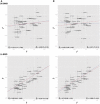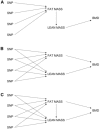Using Mendelian randomization to investigate a possible causal relationship between adiposity and increased bone mineral density at different skeletal sites in children
- PMID: 27215616
- PMCID: PMC5100609
- DOI: 10.1093/ije/dyw079
Using Mendelian randomization to investigate a possible causal relationship between adiposity and increased bone mineral density at different skeletal sites in children
Abstract
Background: Lean mass is positively associated with bone mineral density (BMD). However, the relationship between adiposity and BMD is more controversial. In particular, it is unclear if the observational association between the two reflects a causal effect of fat mass on BMD. Previous Mendelian randomization (MR) studies using variants in the FTO and MC4R genes as genetic instruments for adiposity have suggested that fat mass does indeed causally influence BMD. However, it is possible that these genetic variants pleiotropically influence lean mass and affect BMD through pathways independent of adiposity, invalidating one of the core assumptions of MR and complicating interpretation of the analysis.
Methods: To investigate whether adiposity causally affects BMD, we investigated the relationship between fat mass and BMD at the skull (SK), upper limbs (UL) and lower limbs (LL), spine (SP) and pelvis (PE), using 32 body mass index (BMI)-associated SNPs, including a variant near ADCY3 that was strongly associated with fat but not lean mass in our sample. Dual-energy X-ray absorptiometry (DXA) scans and genetic data were available for 5221 subjects (mean age 9.9 years) from the Avon Longitudinal Study of Parents and Children. We performed a series of MR analyses involving single BMI-associated SNPs and allelic scores of these SNPs. We used new extensions of the MR method including MR Egger regression and multivariable MR, which are more robust to possible confounding effects due to horizontal pleiotropy and, in the case of multivariable MR, specifically account for the effect of lean mass in the analysis. Bidirectional Mendelian randomization analysis was also performed to examine whether BMD causally affected BMI and adiposity.
Results: Observationally, fat mass was strongly positively related to BMD at all sites, but more weakly at the skull. Instrumental variables (IV) analyses using an allelic score of BMI SNPs suggested that fat mass was causally related to LL-BMD, UL-BMD, SP-BMD and PE-BMD but not SK-BMD. Multivariable MR, Egger regression and IV analyses involving the ADCY3 variant suggested a positive causal effect of adiposity on all sites except the skull, and that an effect was present even after taking lean mass into account. Finally, IV analyses using BMD allelic scores showed no evidence of reverse causality between BMD and fat mass.
Conclusions: Our results suggest that adiposity is causally related to increased BMD at all sites except the skull, perhaps reflecting positive effects of loading on bone formation at weighted but not unweighted sites. In contrast, we found no evidence for BMD causally affecting BMI or measures of adiposity. Our results illustrate how MR can be used profitably to investigate clinical questions relevant to osteoporosis.
Keywords: ALSPAC; Bone; Mendelian randomization; body mass index; genetics.
© The Author 2016. Published by Oxford University Press on behalf of the International Epidemiological Association.
Figures




Comment in
-
Why internal weights should be avoided (not only) in MR-Egger regression.Int J Epidemiol. 2016 Oct;45(5):1676-1678. doi: 10.1093/ije/dyw240. Epub 2016 Sep 20. Int J Epidemiol. 2016. PMID: 27649799 No abstract available.
-
Authors' response to Hartwig and Davies.Int J Epidemiol. 2016 Oct;45(5):1678-1679. doi: 10.1093/ije/dyw241. Epub 2016 Sep 20. Int J Epidemiol. 2016. PMID: 27649804 Free PMC article. No abstract available.
References
-
- Davey Smith G, Ebrahim S. ‘Mendelian randomization’: can genetic epidemiology contribute to understanding environmental determinants of disease? Int J Epidemiol 2003;32:1–22. - PubMed
-
- Evans DM, Davey Smith G. Mendelian randomization: new applications in the coming age of hypothesis-free causality. Ann Rev Genom Hum Genet 2015;16:327–50. - PubMed
-
- Lawlor DA, Harbord RM, Sterne JA, Timpson N, Davey Smith G. Mendelian randomization: using genes as instruments for making causal inferences in epidemiology. Stat Med 2008;27:1133–63. - PubMed
Publication types
MeSH terms
Substances
Grants and funding
LinkOut - more resources
Full Text Sources
Other Literature Sources
Medical

